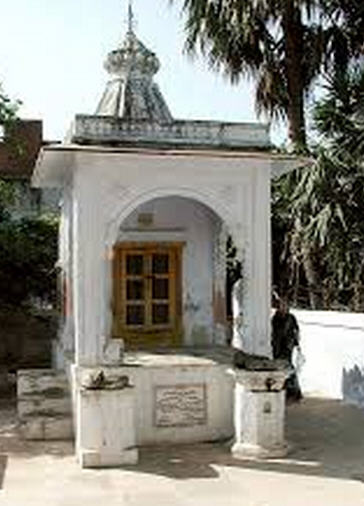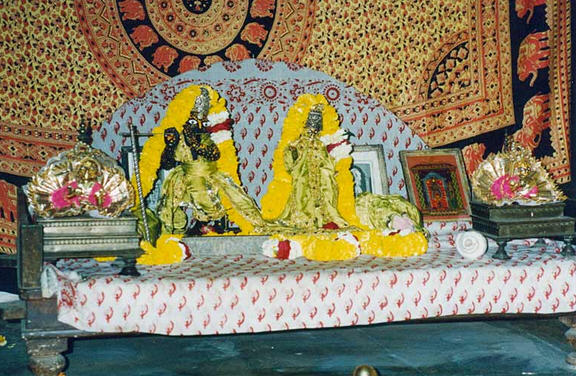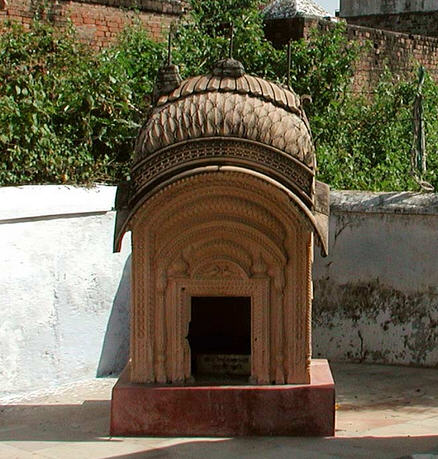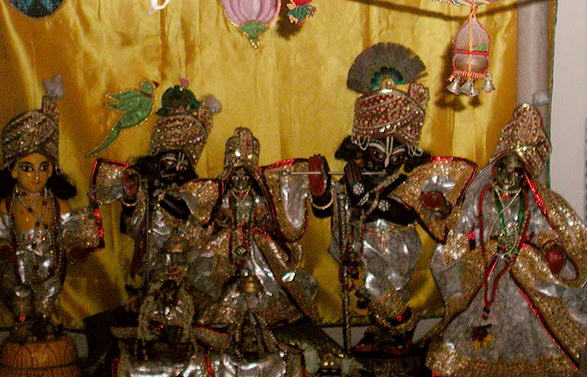In this temple there is the small Radha-Vinoda Deities of Lokanatha Gosvami, the larger Deities of Vijaya Govinda of Baladeva Vidyabhusana and the Radha Gokulananda Deities of Viswanath Cakravarti. The small Deity of Krishna in front of Gokulananda and the Deity of Caitanya Mahaprabhu were worshiped by Narottama Dasa Thakur. Viswanath Cakravarti arranged to have this temple built. Formerly, all the Deities in this temple were worshiped alone in their own temples.
Originally, Viswanath Cakravarti worshiped the Deity of Gokulananda at Radha Kunda. He then moved to Radha Gokulananda, Vrindavana and stayed with Lokanatha Gosvami, where Lokanatha Gosvami would do his bhajana. When the original temple of Radha-Vinoda fell apart, Viswanath Cakravarti had another temple built and called it the Gokulananda temple. Both his Deity of Gokulananda and Radha-Vinoda were worshiped here.

Govardhan Shila of Raghunath Dasa Goswami given by Lord Chaitanya:
There is a Govardhana-shila in this temple that was given by Lord Chaitanya to Raghunath Dasa Gosvami. This shila bears the thumb print of Lord Caitanya. He used to chant while holding the shila, pressing it to His heart or eyes. The shila was always moist with Lord Caitanya’s tears. He would place it on His head or smell it. Lord Chaitanya kept this shila for three years and then gave it to Raghunatha dasa. This shila can be seen if you give a small donation. Krishna Priya Thakurani, the daughter of Ganganarayan Chakravarti , the disciple of Narottama dasa, got the service of worshiping Giridhara, the Govardhana shila of Raghunatha dasa Gosvami.
Originally there was no Deity of Radharani in this temple. Jahnava Devi had a Deity of Radha made in Jagannatha Puri and installed the Deity next to Radha-Vinoda.
This original Deity of Radha-Vinoda is now being worshiped in Jaipur. The Deity was moved to Jaipur to protect the Deity from an attack on Vrindavana by Mughals. This temple contains the pratibhu-murtis of the original Deities. It is considered that there is no different in potency between the original Deity and the pratibhu-murti.
The samadhis of Lokanatha Gosvami, Narottama Dasa, and Visvanatha Cakravarti are located in a small courtyard next to the temple. Lokanatha Gosvami did his bhajana in this courtyard and left his body at this place. In Narottama dasa’s puspa samadhi are his garland, kaupins, cloth and mala. Viswanath Cakravarti Thakura entered samadhi in 1674. He wrote the eight prayers of Sri Gurvashtakam, which are sung every morning in ISKCON temples.
Lokanatha Gosvami was a contemporary of Sri Caitanya Mahaprabhu. When Sri Chaitanya took sannyasa, Lokanatha came to Vrindavana. While visiting the places of Krishna’s pastimes, while in the village of Umaraa in the forest called Chatravana, Lokanatha Gosvami discovered the Deity of Radha-Vinoda. Lokanatha’s samadhi is just north of the village of Umaraa, on the bank of Kishori Kunda. The Deity of Radha-Vinoda was revealed to him from this tank. Lokanatha Gosvami used to carry this Deity in a bag hanging from his neck.
Lokanatha told Lord Caitanya that he did not want to take any disciples. Lord Caitanya told him that he would take only one disciple and that would be sent by Him. When Narottama dasa came to Vrindavana, he was attracted to be initiated by Lokanatha Gosvami. Lokanatha Gosvami refused the repeated requests of Narottama to be initiated. Narottama acted as Lokanatha Gosvami’s menial servant. Every night, Narottama dasa cleaned and swept the place of morning duties of Lokanatha, without his knowledge. He was finally pleased with Narottama and accepted him as his only disciple.
Narottama dasa Thakur, Syamananda Prabhu and Srinivasa Acarya, by the order of Jiva Gosvami, took the original manuscripts of the Gosvami and brought them to Bengal to be copied. These devotees preached the teaching of Caitanya Mahaprabhu where ever they went with great enthusiasm. Visvanatha Cakravarti appeared in the Gaudiya Vaishnava line about a hundred years later. He wrote elaborate philosophical writings.
In this temple you can see the Radha-Vinod Deities of Lokanath Goswami, Radha-Gokulananda Deities of Visvanath Cakravarti, Caitanya Mahaprabhu Deity of Narottam das Thakur, Vijaya Govinda Deities of Baladev Vidyabhusana, and the Govardhan-sila given to Raghunath das Goswami by Sri Caitanya.
Original Deity of Visvanath Cakravarti is the small one in the front. Other Deities are pratibhu-murtis.
The samadhi of Lokanath Goswami:
Lokanath Goswami found Deity of Radha-Vinod (Vinodial) in Umaro Gaon near Chatravan. On the left, we can see the original Deities now worshipped in Jaipur.
In the courtyard of Radha-Gokulananda temple, besides Lokanath’s samadhi there are samadhis of Visvanath Cakravarti Thakur (left), puspa-samadhi of Narottam das Thakur (center) and samadhi of Ganganarayan Cakravarti (right).
Visvanath Cakravarti:
He was the greatest acarya of seventeenth century. His guru Radharaman Cakravarti asked him to copy Srimad-Bhagavatam in his home and while writing, he entered into trance. He wrote day and night. Even though the sun was scorching, but miraculously the spot where he sat was shaded. Another day it rained, but there was no rain on Visvanath Cakravarti. The local landlord saw this miracle and told to townspeople much to Visvanath’s embarrassment. After some time, his spiritual master ordered him to live at Radha-kund and write books.
One brahmacari from Mathura had a dream in which the Lord appeared to him and asked him to give his small Gokulananda Deity to Visvanath. He did so, but Visvanath refused to take the Deity because he could not afford proper worship. That night the Lord appeared to Visvanath and told him that He would arrange everything necessary for the offerings. The brahmacari had another dream and this time Visvanath accepted.
After the disappearance of Jiva Goswami, a controversy arouse among his followers. Some believed that Radha and Krishna are eternally married (svakiya-rasa) and should not be worshipped as paramours in parakiya-rasa. In order to accommodate neophytes Jiva Goswami acknowledged svakiya-rasa in his book Ujjvala-nilamani, but his followers failed to see that in his other books he wrote about parakiya-vada as taught by Lord Caitanya Himself.
Visvanath Cakravarti defeated the controversy, but the pandits got angry and plotted to kill him. They waited for him in secluded place for a long time, but he was not coming. Suddenly they saw a very beautiful young girl picking flowers and they were completely enchanted by her beauty. They forgot their enmity towards Visvanath and asked her who she was. The girl replied she is the maidservant of Sri Radha and he is collecting flowers so that Sri Radha could make a garland for Her beloved paramour, Sri Krishna. Upon saying this, the girl disappeared and the scholars saw only Visvanath sitting there.









